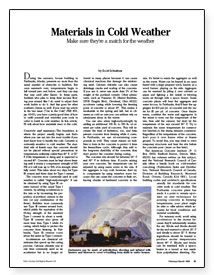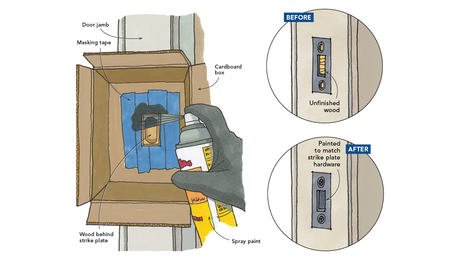
Synopsis: Building materials such as wood, caulk, and concrete don’t like cold weather any more than builders do. This short article discusses how materials react in very low temperatures and how to avoid problems.
During the summer, house building in Fairbanks, Alaska, presents no more than the usual number of obstacles to builders. But once summer’s over, temperatures begin to fall toward zero and below, and they can stay that way until after Easter. In these parts, builders who plan to keep their income flowing year around like I do need to adjust their work habits to do it. And that goes for other northern climes as well. In this article, I’ll talk about how materials react to the cold.
Concrete and masonry
The foundation is where the project usually begins, and that’s where you can run into the most trouble if you don’t know how to handle the cold. Concrete is extremely sensitive to cold weather. The standard rule of thumb says that concrete should not be placed without special precautions in temperatures uniformly colder than 40° F, or 32° F if the temperature is rising and is expected to exceed 40°. Concrete must be kept above freezing until it attains a compressive strength of 500 PSI or it will lose up to 50% of its strength when fully cured. This takes about two days for Type III cement and three days for Type I cement.
The concrete most commonly used in cold weather is called “high-early-strength.” It can be obtained by using Type III cement instead of the usual Type I cement, by adding accelerators to the mix or by increasing the proportion of portland cement in the mix (or any combination of the three). Builders most commonly use Type III cement around here, which yields the equivalent of the 28-day strength of the standard Type I cement in about a week. Type III cement also gives off more heat than Type I while it’s curing, which helps to protect the concrete from freezing. In Fairbanks, Type III cement costs about the same as Type I cement.
Accelerators are chemical admixtures that speed up the curing process. Calcium chloride was at one time commonly used as an accelerator but is no longer allowed in many places because it can cause chemical reactions that damage the reinforcing steel. Calcium chloride can also cause shrinkage cracks and scaling of the concrete. If you use it, never use more than 2% of the weight of the portland cement. Other admixtures, such as Pozzutec 20 (Master Builders, Cleveland, Ohio) accelerate curing while lowering the freezing point of concrete to about 20°. This makes it invaluable in the spring and fall, but in climates as cold as ours you can seldom rely on admixtures alone in the winter.
For more photos and details, click the View PDF button below:


























